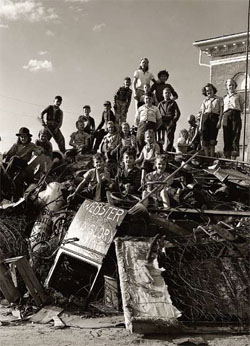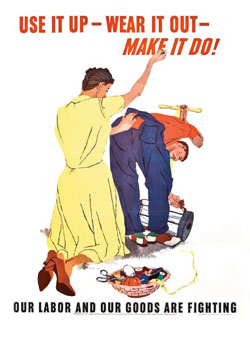Montana: Stories of the Land
Companion Website and Online Teacher's Guide
Chapter 19 - World War II in Montana
Chapter 1 - Montana: Where the Land Writes History
Chapter 2 - People of the Dog Days
Chapter 3 - From Dog Days to Horse Warriors
Chapter 4 - Newcomers Explore the Region
Chapter 5 - Beaver, Bison, and Black Robes
Chapter 6 - Montana's Gold and Silver Boom
Chapter 7 - Two Worlds Collide
Chapter 8 - Livestock and the Open Range
Chapter 9 - Railroads Link Montana to the Nation
Chapter 10 - Politics and the Copper Kings
Chapter 11 - The Early Reservation Years
Chapter 12 - Logging in the "High Lonesome"
Chapter 13 - Homesteading This Dry Land
Chapter 14 - Towns Have Lives, Too
Chapter 15 - Progressive Montana
Chapter 16 - Montana and World War I
Chapter 17 - Montanans on the Move
Chapter 18 - The Great Depression Transforms Montana
Chapter 19 - World War II in Montana
Chapter 20 - Building a New Montana
Chapter 21 - A People's Constitution
Chapter 22 - Living in a New Montana
Educator Resources
Educational Trunks
-
The Home Fires: Montana and World War II from the Montana Historical Society. This trunk explores aspects of everyday life in Montana during the 1941 to 1945 war years, including little-known government projects such as the Fort Missoula Alien Detention Center and Civilian Public Service Camps.
Takeaways
-
Inspired by reading specialist Tammy Elser, who was in turn inspired by SKC graduate Taylor Crawford, we've created a "Takeaway" bookmark for every chapter of Montana: Stories of the Land. Before starting a chapter, print and cut out these bookmarks and distribute them to your students. Ask them to use the Takeaway to summarize the GIST of what they learn from reading assigned sections of the chapter. Remind them that they don't have much room, so they'll need to think before they write down the most important idea they want to take away from the section. Learn a little more about the GIST strategy.
-
Even though we've created Takeaways for every chapter, we don't recommend you have your students complete a Takeaway for every section of every chapter they read. That would be exceedingly tedious. However, used appropriately, they can be a useful tool for encouraging reflection and teaching students how to summarize information.
Websites and Online Lesson Plans
-
World War II propaganda has received much attention, including a National Archives exhibit, Powers of Persuasion: Poster Art from World War II.
-
The National World War II Memorial in cooperation with the History Channel created an extensive teacher's guide to the national history of World War II.
-
Jean Luckowski and James Lopach, the authors of Jeannette Rankin: A Political Woman (Boulder, CO, 2004) have created a timeline of Rankin's life, illustrated with quotations by and about her. Page 15 of the document includes a list of excellent discussion questions. For more on Jeannette Rankin see "Jeannette Rankin: Suffragist, Congresswoman, Pacifist."
-
Excerpts from letters written by Montanans serving during World War II are included in "Reader's Theater: Letters Home from Montanans at War," a unit that asks students to work in groups to read, interpret, and perform letters written by soldiers at war, from the Civil War to the Operation Iraqi Freedom.
-
Information on the Smith Mine Disaster can be found here. A 6:23 minute narrated PowerPoint is available here.
-
The Billings Gazette has created a gallery of five front-page news stories covering the 1943 Smith Mine disaster.
Videos or DVDs
-
Homefront: United or Divided - 27 minutes.
-
Unladylike2020: Unsung Women Who Changed America--Jeannette Rankin: First Woman Member of the U.S. Congress -12:30 minutes
-
Against The Darkness: A Tribute to the Montana Coal Miner - 30 minutes. Buy the DVD or view on YouTube.
-
Bella Vista, An Unseen View of WWII - 30 minutes.
-
Chapter 12, "Montana's Response to Global Conflict," (17 minutes) of Montana Mosaic: 20th Century People and Events focuses on Jeannette Rankin's story. (Site includes links to both User Guides with discussion questions and videos.)
Possible Field Trips: View the Map
-
Carbon County Historical Society, Red Lodge
-
The World War II Alien Detention Center Barracks at the Historical Museum at Fort Missoula
Chapter 19 Test and Answer Keys Page
The tests and answer keys are password protected.
You can contact us to receive the password:
- Martha Kohl - call (406) 444-4790 or email mkohl@mt.gov
- Melissa Hibbard - call (406) 444-4741 or email Melissa.Hibbard@mt.gov
Or, if you used the old system, the original username is now the new password. You will be asked for this case-sensitive password every time you open a new document.
Alignment to ELA Common Core Standards
Content Standards and Essential Understandings Regarding Montana Indians (EU)



